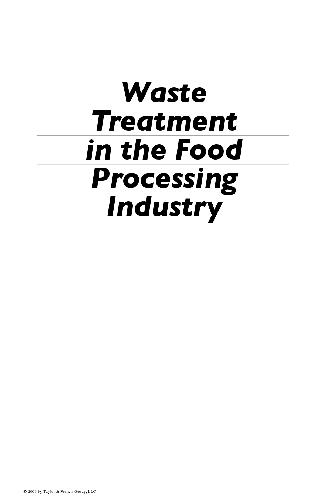0-8493-7236-4
Table of contents :
Waste Treatment in the Food Processing Industry……Page 2
Preface……Page 4
Contents……Page 6
Contributors……Page 7
Table of Contents……Page 0
1.1 INTRODUCTION……Page 8
1.2.3 Cheese……Page 9
1.2.6 Ice Cream……Page 10
1.3 CHARACTERISTICS AND SOURCES OF WASTEWATER……Page 11
1.4.1 Direct Discharge to a Sewage Treatment Works……Page 12
Flow and Composition Balancing……Page 15
Fats, Oil, and Grease Removal……Page 16
Biological Treatment……Page 17
Irrigation……Page 27
1.4.4 Sludge Disposal……Page 28
The Final Process……Page 29
The Final Process……Page 30
1.7 CONCLUSIONS……Page 31
REFERENCES……Page 32
2.1 INTRODUCTION……Page 36
Solids Content……Page 37
2.2.2 Organic Content……Page 38
Biochemical Oxygen Demand……Page 39
2.2.3 Nitrogen and Phosphorus……Page 40
2.3 PRIMARY TREATMENT……Page 41
2.3.1 Screening……Page 42
2.3.2 Sedimentation……Page 43
2.3.3 Flow Equalization……Page 45
2.3.5 Flotation……Page 46
2.4 BIOLOGICAL TREATMENT……Page 48
Activated Sludge Systems……Page 49
Aerated Lagoons……Page 52
Trickling Filters……Page 53
Rotating Biological Contactors (RBC)……Page 55
Digestion Systems……Page 56
Imhoff Tanks……Page 58
2.5.1 Coagulation/Flocculation……Page 59
2.5.2 Electrocoagulation……Page 60
Chlorination……Page 61
Ozonation……Page 62
2.6 LAND DISPOSAL OF WASTEWATER……Page 63
2.6.1 Loading Rates……Page 64
2.7 GENERAL SEAFOOD-PROCESSING PLANT SCHEMES……Page 65
2.8.2 Cost of Operation and Maintenance……Page 67
Estimation of Total Costs……Page 69
REFERENCES……Page 71
3.1 THE MEAT INDUSTRY……Page 74
3.2.1 Waste Characteristics and Quantities Generated……Page 75
Wastewater Flow……Page 77
Wastewater Characteristics……Page 80
3.3 WASTEWATER MINIMIZATION……Page 82
3.4 WASTEWATER TREATMENT PROCESSES……Page 84
Primary Treatment……Page 85
Physicochemical Secondary Treatment……Page 87
Biological Secondary Treatment……Page 88
3.4.2 Anaerobic Treatment……Page 89
Waste Stabilization Ponds……Page 92
Biological Filters……Page 94
Rotating Biological Contactors……Page 96
Activated Sludge……Page 97
3.5 SOLID WASTES……Page 99
3.5.1 Land Disposal……Page 100
3.5.2 Composting……Page 101
3.5.3 Anaerobic Digestion……Page 102
REFERENCES……Page 103
Sterilization……Page 108
Oil Clarification and Purification……Page 109
Nut Cracking……Page 110
Deodorization……Page 111
4.2.2 Biological Treatment……Page 112
Pretreatment……Page 113
Open Digester and Ponding Systems……Page 114
4.3 PALM OIL REFINERY EFFLUENT (PORE)……Page 116
4.3.1 Chemical Properties of PORE……Page 117
Evaporation Technology……Page 119
Compost……Page 120
Biological Hydrogen……Page 121
4.5 FUTURE TRENDS……Page 122
REFERENCES……Page 123
5.1 INTRODUCTION……Page 125
5.2 OLIVE OIL MILL TECHNOLOGY……Page 126
5.3 OLIVE OIL WASTEWATER CHARACTERISTICS……Page 128
Solution……Page 132
5.4 ENVIRONMENTAL RISKS……Page 133
5.4.3 Threat to Aquatic Life……Page 134
5.5 LIQUID WASTE TREATMENT METHODS……Page 135
5.5.1 Low-Cost Primitive Methods……Page 136
Treatment of Olive Oil Mill Wastewaters in Municipal Plants……Page 138
Case Study……Page 141
Solution……Page 142
Principle of Anaerobic Fermentation……Page 144
Factors Affecting Anaerobic Process Operation……Page 145
Anaerobic Treatment Systems of Wastewater……Page 146
Case Studies……Page 149
Solution……Page 152
Treatment on Site……Page 154
Solution……Page 157
Solution……Page 158
Solution……Page 160
5.5.9 Wet Air Oxidation and Ozonation……Page 161
Principle of Wet Air Oxidation (WAO)……Page 162
Case Studies……Page 163
5.5.10 Fungal Treatment……Page 166
5.5.11 Decolorization……Page 167
Case Study……Page 168
5.5.12 Precipitation/Flocculation……Page 170
5.5.13 Adsorption……Page 171
5.5.14 Biofiltration and Ultrafiltration……Page 173
5.5.15 Evaporation/Drying……Page 175
5.5.16 Electrolysis……Page 176
Case Studies……Page 177
Case Study……Page 179
Significance of Submarine Outfalls……Page 180
Specific Pretreatments and Quality Limits……Page 181
Disposal of OME Through Submarine Outfalls……Page 182
5.6.1 Biotechnological Processes……Page 184
Principle of Fluidized/Moving Beds (Flumov)……Page 185
Case Studies……Page 186
Case Study……Page 189
5.6.4 Examples of Technologies and Treatments……Page 190
5.7 ECONOMY OF TREATMENT PROCESSES……Page 192
REFERENCES……Page 194
6.2 POTATO PROCESSING AND SOURCES OF WASTEWATER……Page 199
Peeling……Page 200
Frozen French Fries……Page 201
Potato Starch……Page 203
6.3.1 Overview……Page 208
Sources of Wastewater [20]……Page 210
6.4 TREATMENT METHODS……Page 215
In-Plant Treatment……Page 216
Primary Treatment……Page 219
Equalization……Page 223
Secondary Treatment……Page 225
Case Studies……Page 231
Case Studies……Page 244
Advanced Treatment……Page 251
6.5.1 In-Plant Usage of Potato Scraps……Page 254
6.5.5 Cattle Feed……Page 255
REFERENCES……Page 256
7.1 INTRODUCTION……Page 261
Caffeine……Page 262
Acids……Page 264
Inspection……Page 265
7.3 BIOLOGICAL TREATMENT FOR SOFT DRINK WASTEWATER……Page 266
7.4.1 Aerobic Suspended Growth Treatment Process……Page 267
7.5 ANAEROBIC WASTEWATER TREATMENT……Page 268
7.5.1 Upflow Anaerobic Sludge Blanket Reactor……Page 269
7.5.2 Anaerobic Filters……Page 271
7.5.3 Anaerobic Fluidized Bed Reactor……Page 273
REFERENCES……Page 274
8.1 INTRODUCTION……Page 276
8.2.3 Wastewater……Page 278
8.3 BAKERY WASTE TREATMENT……Page 279
8.4.3 FOG Separation……Page 280
8.4.6 Sedimentation……Page 282
8.5 BIOLOGICAL TREATMENT……Page 283
8.6.1 Activated Sludge Process……Page 284
8.6.2 Trickling Filter Process……Page 286
8.7 ANAEROBIC BIOLOGICAL TREATMENT……Page 287
8.8.3 VOC……Page 288
8.10.1 Concepts……Page 290
Assessment of Waste……Page 291
REFERENCES……Page 293
9.2 STRUCTURAL POINT OF VIEW……Page 295
9.3.1 Wastewater Treatment Systems for Food Processing……Page 297
9.3.2 Effluent Guidelines and Standards for Food Processing……Page 298
9.4.1 Organic Residual Wastes……Page 299
Feedstuff Use……Page 301
9.4.2 Vessels, Containers, and Wrapping Wastes……Page 303
9.5.2 Accidentally Contaminated Food Wastes……Page 304
9.5.3 Incineration Ash of Food Wastes……Page 305
Bread Yeast……Page 307
Nucleotides……Page 308
Example of Comprehensive Fermentation Factory……Page 311
9.6.2 Agro-Industries in Tropical Countries……Page 313
9.6.3 UASB and EGSB Treatment Systems……Page 315
Composting……Page 317
9.7 CONCLUSION……Page 320
REFERENCES……Page 321







Reviews
There are no reviews yet.